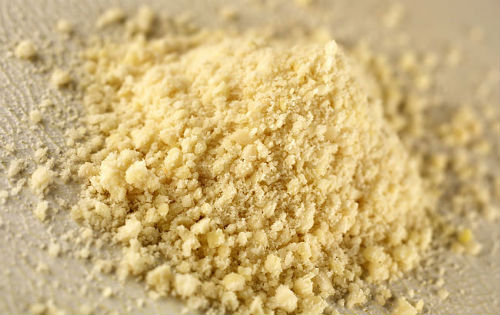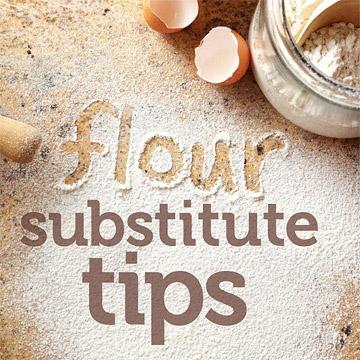Removing refined sugar and flour is one of the most important steps you can take for your health. Not all carbs are bad, but too much of the white ones leads to funky stuff. They push your body into fat storing mode, and do very little for your satiety, hormones, and waistline.
But of course that brings us to a familiar problem:
They taste great!
I mean, damn, almost every savory food we love to eat has them as a main ingredient.
You don’t want to get fat, but do you also want to go your whole life refraining from the foods you love? Or the foods your friends, children, and spouse love and always want to eat when you go out?
It’s a bitter irony that your easiest, most delicious source of calories are the same ones that get your pancreas gushing out insulin at breakneck speed.
A life of morbid health isn’t worth living……..but one without carbs might be almost as bad!
So if you’re as perplexed by this dilemmas as I am, here are some useful substitutes for the white powder.

1). Almond Meal and Coconut Flour
Almond and coconut flour are great for people who like to bake. They’re both low carb, high fiber, gluten free and mildly sweet. They are not low calorie, but are good sources of omega 3 fats, protein and fiber. They’re digested much more slowly than regular fiber.
Coconut flour is made from the fibrous part of the coconut and has more carbs than almond meal, but it’s mostly non-digestible. It has a sweet flavor, and you should substitute regular flour for coconut flour on a 4:1 basis. (Ie, use 1/4 c coconut flour for 1 c flour).
Almond meal is ground up almonds that are pulverized into a fine dust. Most of its calories are from fat, and it can be used on a 1:1 basis for regular flour.
Both of these give food a light, fluffy texture that’s a little on the moist side.
Best for: baking, pancakes & waffles, batters.
Where to buy: Almond meal and coconut flour can both be had at nuts.com
Recipes: pancakes, muffins, banana bread.

Cauliflower
Can a bland, cruciferous vegetable really be made to taste starchy and savory?
YES!
If you prepare them right mashed cauliflower is an amazing facsimile of mashed potatoes. In fact, after eating them regularly at my local health food restaurant I’ve come to enjoy the taste more than the traditional dish.
They’re easy to make, but you need a good blender or food processor. You have to steam the florets for about 15 minutes and blend them until smooth and add garlic, lemon, and olive oil.
Best for: mashed potatoes replacement.
Recipes: buttermilk mashed cauliflower, creamy garlic mashed cauliflower

Vegetable Gums
Vegetable gums are gelatinized extracts from different plants like seaweed, plums, and tree bark. Some people don’t react well to them and I would not recommend eating them on a regular basis and some people ought to avoid them entirely because they can cause gastrointestinal irritation.
However, in small quantities they are a useful way to thicken sauces and stews without adding flour and calories. They’re effective in small doses and have no flavor so they’re very versatile. You also have to be careful not to use too much, because they’ll make your foods overly “gummy” if you’re not careful.
The most common vegetable gum in stores is xantham gum, and you can buy a small bag for about $5, which should be enough to last even a serial cooker several months.
Another option is a product called ThickenThin Not/Starch Thickener. Perhaps the most confusingly titled product I’ve ever seen, but it works well and is less volatile than traditional vegetable gums since it’s a blend of four.
In my own home I find myself using almond flour and vegetable gums the most often on this list because they’re affordable and can be used in a wide variety of foods. However, all serve their purpose extremely well if you’re looking to reduce the insulin load in your diet.

I like to use tapioca starch. It’s a lot like almond flour but I think the taste and texture is better in baked dishes. It’s almost creamy and gives sauces and baked goods a really nice texture.
LikeLike
Jonathan, I love the cauliflower suggestion, but you should know that coconut flour and almond flour really don’t work as a 1:1 substitute for wheat flour if you are baking. Also, the vegetable gums??? Xantham gum is exactly that – gummy! And it tastes horrible. Have you ever tried kudzu starch, or even organic corn starch would be better than gums. Here is a link for kuzu http://www.edenfoods.com/store/product_info.php?products_id=109630
LikeLike
Heather,
Thanks for this recommendation. I’ve never heard of kudzu starch, but you’re right it looks better than what I mentioned!
LikeLike
These Lemon Meltaways nail both targets right on the head. The base, made from ground nuts or seeds (your choice), offers plenty of plant-based protein and healthy fat. A blend of honey (or any liquid sweetener), tangy lemon juice and zest, and pure vanilla extract infuses loads of flavor into the treats without unnecessary allergenic ingredients like refined flour, sugar, or dairy.
LikeLike